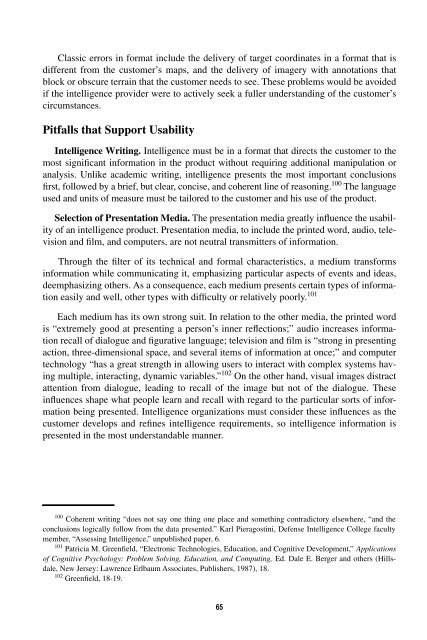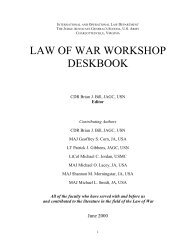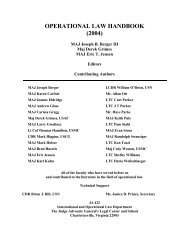learning with professionals - Higgins Counterterrorism Research ...
learning with professionals - Higgins Counterterrorism Research ...
learning with professionals - Higgins Counterterrorism Research ...
Create successful ePaper yourself
Turn your PDF publications into a flip-book with our unique Google optimized e-Paper software.
Classic errors in format include the delivery of target coordinates in a format that is<br />
different from the customer’s maps, and the delivery of imagery <strong>with</strong> annotations that<br />
block or obscure terrain that the customer needs to see. These problems would be avoided<br />
if the intelligence provider were to actively seek a fuller understanding of the customer’s<br />
circumstances.<br />
Pitfalls that Support Usability<br />
Intelligence Writing. Intelligence must be in a format that directs the customer to the<br />
most significant information in the product <strong>with</strong>out requiring additional manipulation or<br />
analysis. Unlike academic writing, intelligence presents the most important conclusions<br />
first, followed by a brief, but clear, concise, and coherent line of reasoning. 100 The language<br />
used and units of measure must be tailored to the customer and his use of the product.<br />
Selection of Presentation Media. The presentation media greatly influence the usability<br />
of an intelligence product. Presentation media, to include the printed word, audio, television<br />
and film, and computers, are not neutral transmitters of information.<br />
Through the filter of its technical and formal characteristics, a medium transforms<br />
information while communicating it, emphasizing particular aspects of events and ideas,<br />
deemphasizing others. As a consequence, each medium presents certain types of information<br />
easily and well, other types <strong>with</strong> difficulty or relatively poorly. 101<br />
Each medium has its own strong suit. In relation to the other media, the printed word<br />
is “extremely good at presenting a person’s inner reflections;” audio increases information<br />
recall of dialogue and figurative language; television and film is “strong in presenting<br />
action, three-dimensional space, and several items of information at once;” and computer<br />
technology “has a great strength in allowing users to interact <strong>with</strong> complex systems having<br />
multiple, interacting, dynamic variables.” 102 On the other hand, visual images distract<br />
attention from dialogue, leading to recall of the image but not of the dialogue. These<br />
influences shape what people learn and recall <strong>with</strong> regard to the particular sorts of information<br />
being presented. Intelligence organizations must consider these influences as the<br />
customer develops and refines intelligence requirements, so intelligence information is<br />
presented in the most understandable manner.<br />
100 Coherent writing “does not say one thing one place and something contradictory elsewhere, “and the<br />
conclusions logically follow from the data presented.” Karl Pieragostini, Defense Intelligence College faculty<br />
member, “Assessing Intelligence,” unpublished paper, 6.<br />
101 Patricia M. Greenfield, “Electronic Technologies, Education, and Cognitive Development,” Applications<br />
of Cognitive Psychology: Problem Solving, Education, and Computing, Ed. Dale E. Berger and others (Hillsdale,<br />
New Jersey: Lawrence Erlbaum Associates, Publishers, 1987), 18.<br />
102 Greenfield, 18-19.<br />
65

















